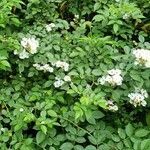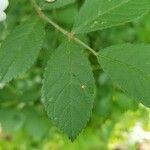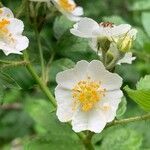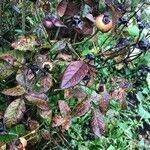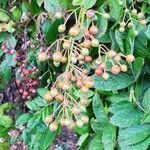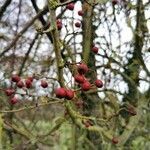Scrambling shrub or liane, ± deciduous; stems often long and climbing to c. 6 m high, often intertwining and much-branched, often layering, glabrous; armature 0 or of few to numerous, ± uniform, flattened, falcate prickles. Lvs with 3-4 pairs of leaflets; petiole 15-30-(35) mm long, tomentose and sometimes with glandular hairs; stipules adnate for c. ⅔, usually densely clothed in glandular hairs and moderately to densely puberulent, pectinate with many narrow lobes, sometimes the lobes pinnately divided. Lamina of leaflets 15-50-(60) × 10-30 mm, elliptic to oblanceolate or obovate, shining deep green and glabrous above, moderately to densely clothed in eglandular hairs beneath; margins serrate; base cuneate to rounded; apex acute to acuminate or cuspidate. Fls usually numerous in a pyramidal panicle, occasionally few, single, or rarely semi-double with c. 10 petals, 20-25 mm diam.; pedicels and peduncles moderately to densely pilose. Sepals deciduous, lanceolate to elliptic-ovate, acuminate, tomentose inside and on margins, with very few to many glandular hairs outside and on margins; outer sepals usually pinnately divided with a few narrowly linear lobes. Petals 8-14 mm long, obovate or broadly obovate, white or slightly pink. Styles fused in a column, well-exserted, glabrous. Fr. 6-8 × 4-5 mm, ± ellipsoid, glabrous, shining red or deep orange.
Shrubs climbing. Branchlets terete, usually glabrous; prickles paired below leaves, sometimes sparsely scattered, curved, to 6 mm, stout, flat, gradually tapering to broad base. Leaves including petiole 5–10 cm; stipules pectinate, mostly adnate to petiole, margin glandular-pubescent or not; rachis and petiole pubescent or glabrous, glandular-pubescent, shortly prickly; leaflets (3–)5–9, obovate, oblong, or ovate, 1–5 × 0.8–2.8 cm, abaxially pubescent, adaxially glabrous, base rounded or cuneate, margin simply serrate, apex acute or rounded-obtuse. Flowers numerous in corymb, 1.5–4 cm in diam.; pedicel 1.5–2.5 cm, puberulous, glabrous, or glandular-pubescent, margin sometimes pectinate; bracts at base of pedicel, small. Hypanthium subglobose, glabrous. Sepals 5, deciduous, lanceolate, abaxially glabrous, adaxially pubescent, margin entire or with 2 linear lobes at middle. Petals 5, semi-double or double, white, pinkish, or pink (in some cultivated plants), fragrant, obovate, base cuneate, apex emarginate. Styles connate in column, exserted, slightly longer than stamens, glabrous. Hip red-brown or purple-brown, subglobose, 6–8 mm in diam., glabrous, shiny. 2n = 14*, 21.
Vigorously colonial; stems climbing or scrambling to 3 m; stipules conspicuously pectinate-serrate and glandular-ciliate; lfls 5–11, to 2.5 cm, elliptic to obovate; infl many-fld; sep often caudate-tipped, often with some slender lateral lobes, eventually deciduous; pet white (pink) 1–1.5(–2) cm; styles connate, exserted 1.5–3 mm, glabrous; 2n=14. Native of e. Asia, often escaped from cult.
A climbing rose. It has a stem which arises as a small arch from the roots then lays along the ground. It grows 3-4.5 m high and spreads 3 m wide. The stems are prickly. The leaves have 7-9 leaflets. The flowers are 3 cm across. The fruit are red to black hips.
